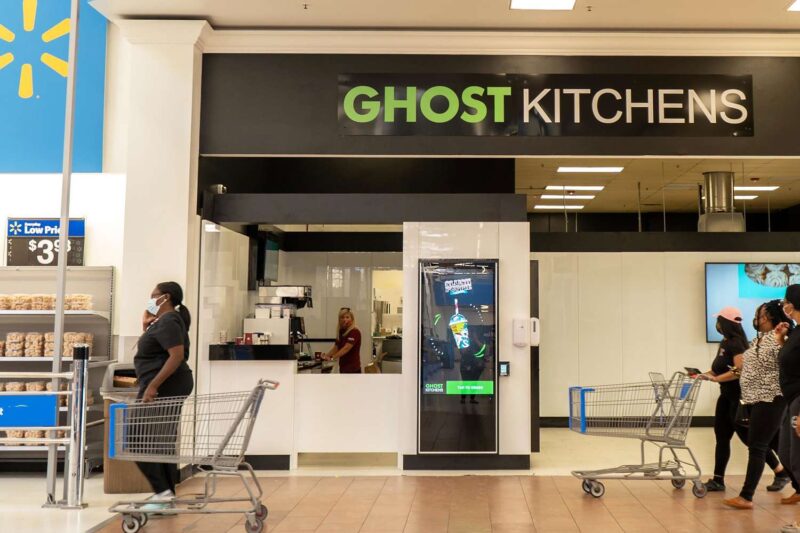🍽️🔍 Embarking on the journey of starting a ghost kitchen requires a meticulous blend of culinary passion, strategic planning, and technological innovation. Here’s a comprehensive guide to navigate through the essential steps of setting up your own ghost kitchen, culminating in a seamless and rewarding culinary venture.

1. Decide on a Brand & Concept & Define Your Culinary Identity:
Before delving into the practicalities, take a moment to envision your ghost kitchen’s identity. Determine the culinary niche, be it gourmet burgers, authentic ethnic cuisine, or health-conscious options. This decision will guide your menu, marketing, and overall brand strategy.
Know Your Audience:
Understand your target audience – their preferences, dietary habits, and online behavior. Tailor your brand to meet the needs of your chosen demographic, ensuring a more effective and resonant presence in the market.
2. Build a Business Plan
Define Your Objectives:
Craft a business plan that outlines your ghost kitchen’s objectives. Clearly state your mission, vision, and short- and long-term goals. This document should serve as a comprehensive guide, detailing your unique value proposition and strategies for achieving success.
Market Research:
Conduct thorough market research to identify potential competitors, consumer demands, and industry trends. This data will inform your business decisions, helping you navigate challenges and seize opportunities.
3. Secure Financial Funding
Determine Startup Costs:
List all the costs associated with launching your ghost kitchen, including equipment, kitchen space, licenses, and marketing. This detailed breakdown will serve as the basis for your funding requirements.
Explore Funding Options:
Consider various funding options such as personal savings, loans, investors, or partnerships. Evaluate the pros and cons of each to determine the most suitable and sustainable financial model for your ghost kitchen.
4. Choose the Right Location
Assess Demand and Competition:
Identify areas with high demand for your cuisine and minimal competition. Consider the demographic profile of potential customers and assess the accessibility of each location.
Cost-Benefit Analysis:
Factor in costs such as rent, utilities, and logistics when choosing your ghost kitchen’s location. A comprehensive cost-benefit analysis will help you make an informed decision that aligns with your budget and business goals.
5. Obtain all the Legal Licenses and Permits
Research Local Regulations:
Familiarize yourself with local health department regulations, zoning requirements, and food safety standards. Compliance with these regulations is crucial to ensure the legality and safety of your operations.
Licensing and Permits:
Secure all necessary licenses and permits, which may include health permits, food handling licenses, and zoning permits. Work closely with local authorities to navigate the bureaucratic landscape and obtain the required approvals.
6. Scale with Your Own Online Delivery App
Embrace Digital Transformation:
Invest in developing your own online delivery app to streamline the ordering and delivery process. A user-friendly app not only enhances customer experience but also provides valuable data for marketing and operational improvements.
Integration with Third-Party Platforms:
Consider integrating your app with popular third-party delivery platforms to expand your reach. Utilize technology to manage orders efficiently and gain insights into customer behavior.
7. Hire and Train Your Kitchen Staff
Assemble a Skilled Team:
Recruit skilled chefs, cooks, and support staff who align with your culinary vision. Look for individuals who share your passion for delivering high-quality, consistent dishes.
Comprehensive Training:
Implement a robust training program covering food preparation, safety protocols, and customer service. Consistent training ensures that your kitchen staff operates with precision, delivering a seamless and enjoyable dining experience.
8. Kickstart Marketing & Advertising
Develop a Marketing Strategy:
Craft a multifaceted marketing strategy that encompasses both online and offline channels. Leverage social media platforms, collaborate with food influencers, and explore partnerships with food delivery apps.
Targeted Advertising:
Implement targeted advertising campaigns to reach your desired audience. Utilize analytics to measure the effectiveness of your campaigns and adjust strategies accordingly.
Embarking on the journey of starting a ghost kitchen involves a careful blend of culinary passion, business strategy, and technological innovation. By meticulously following these eight steps, you can navigate the intricacies of establishing and running a successful ghost kitchen. Each phase contributes to the overall tapestry of your culinary venture, ensuring a delightful experience not only for your customers but for you as an entrepreneur.
Building the right mobile app can be quite a challenge. However, with eddress technology, you can sidestep the common pitfalls, as we have extensive experience in the Ghost Kitchen industry.
Have an e-commerce mobile app idea that you would like to build? eddress can definitely help you!
Visit our website and let’s get on a call!
For more content like this, visit our blog!







